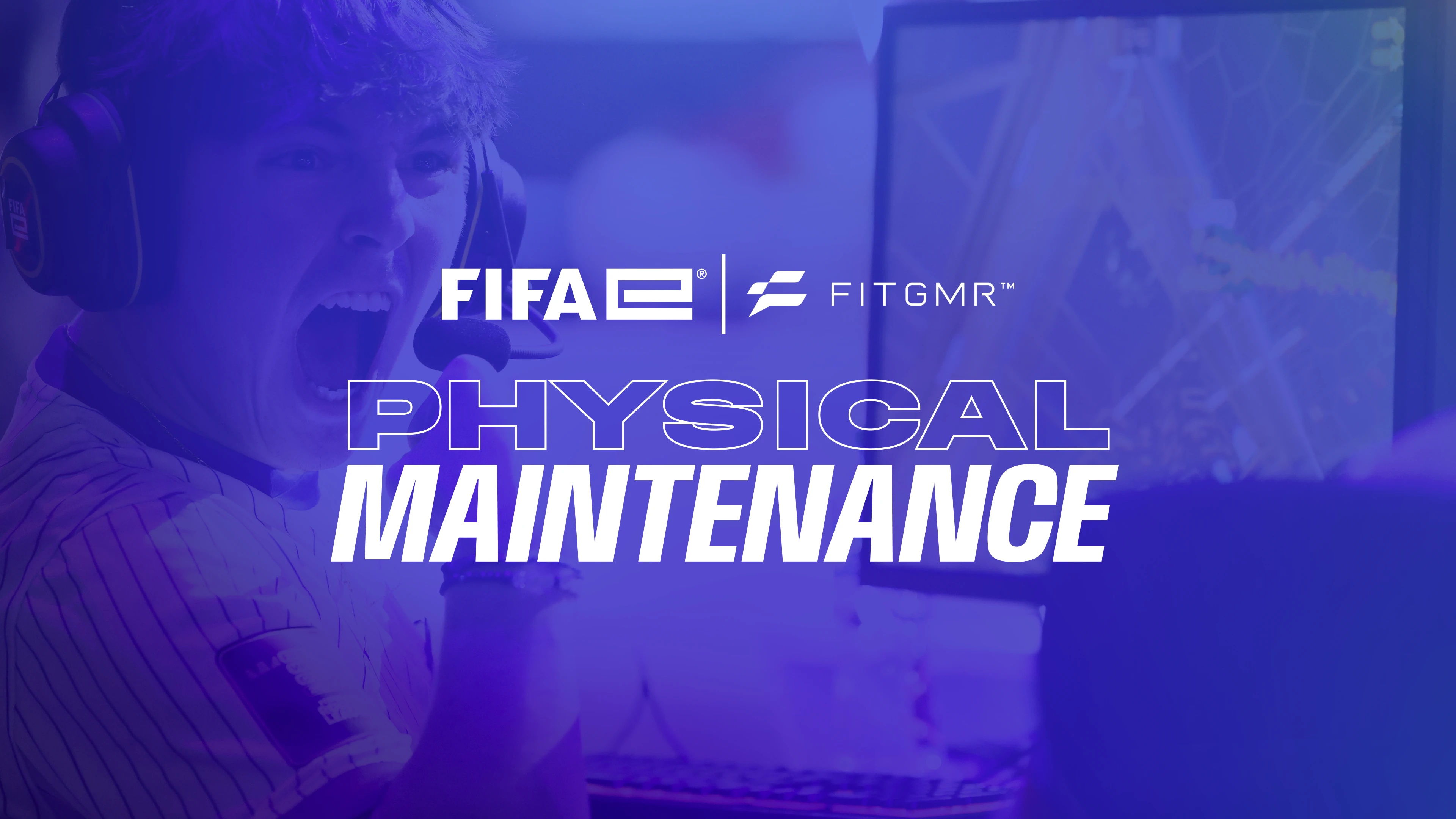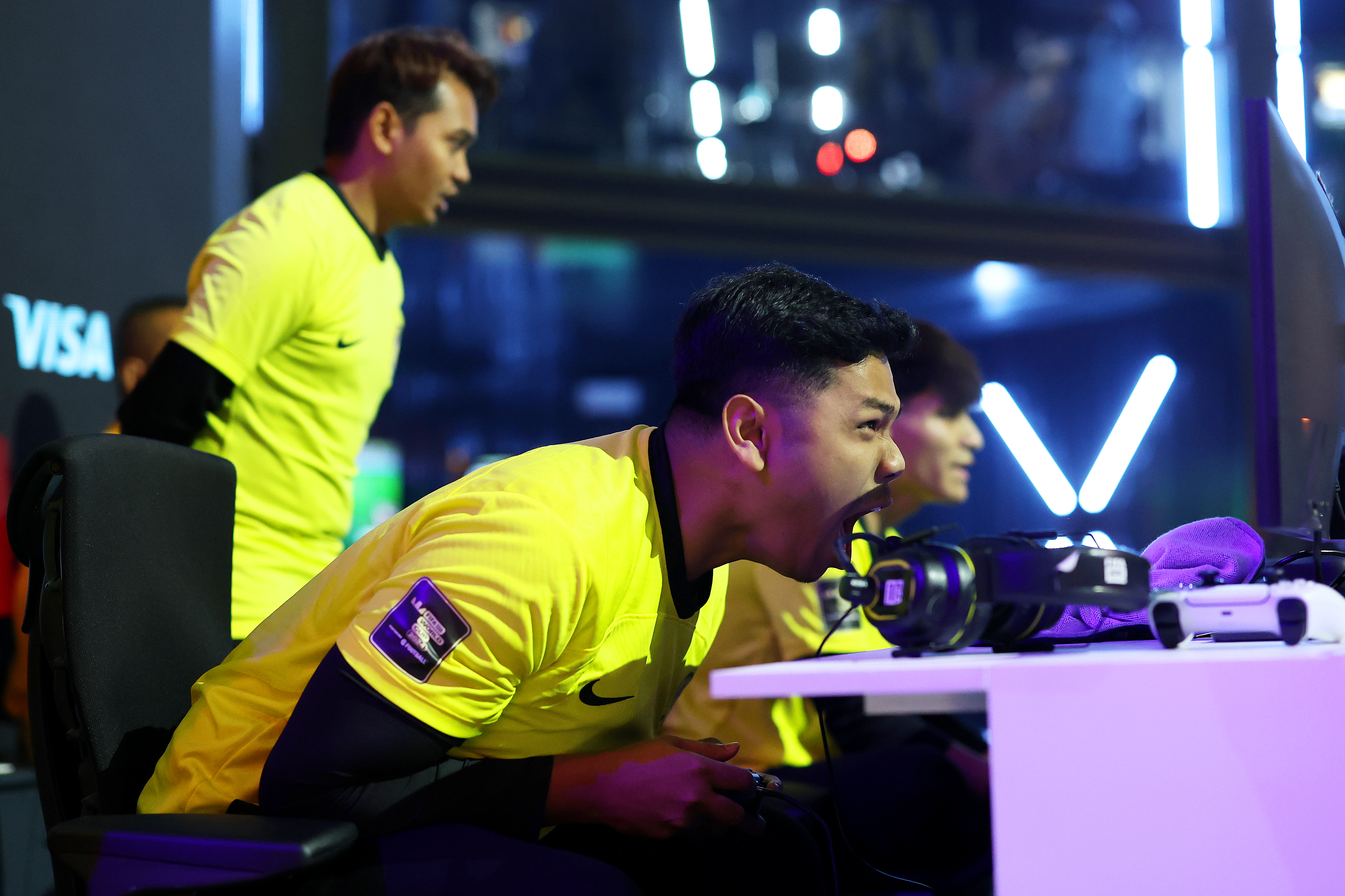
Your browser is not supported.
We are sorry, but the version of your browser is not able to display the content of fifa.gg. Please download the latest version or visit fifa.com.
Visit fifa.com01.09.2025
Physical health and activity are essential to a long and successful esports career. While competitive gaming may not look physically demanding, your body is constantly engaged—especially during high-stress moments.
That’s why physical maintenance is one of the five key pillars of player health, and why FIFAe actively promotes body awareness and movement as part of its holistic approach to sustainable performance. Through initiatives like the Good Game Promise and dedicated partnerships with health experts such as FITGMR, FIFAe empowers players to build routines that support long-term physical wellbeing—on and off the stage.
FIFAe’s Good Game Promise goes beyond fair play; it’s a roadmap for sustainable performance. From daily movement tips to esports-specific warmups and expert-backed routines, FIFAe empowers players to see physical health as a competitive edge.
We provide players and coaches with science-backed content, practical tools, and shareable resources so physical wellbeing becomes a regular part of matchday, practice, and season plans.
Though players may be seated, their bodies work hard during competitions:
High-pressure moments spike heart rates and hormone levels, which can affect reaction time, decision-making and overall gameplay.
Repetitive motion leads to overuse injuries — from wrists and necks to shoulders and backs.
Fatigue sets in faster when your body lacks movement, circulation, and energy.
Building consistent physical maintenance habits is a win condition. FIFAe offers reminders, tips, and tools to keep this top of mind for players and coaches.
You don’t need to be a gym rat to stay game ready. What matters most is consistency and variety.
15–20 minutes of daily movement can prevent common gaming injuries like carpal tunnel, “mouse arm,” and text neck.
Dance, walk, bike, hike, skateboard — just don’t stay still.
Go outside. Move with friends. Break the monotony of training blocks with bursts of real-world energy [1], [2].
Ergonomic gear helps, too. A good chair, wrist support, or blue-light glasses can reduce strain and boost posture, comfort, and focus over time.
Certain workouts stimulate gains and cognition. FITGMR app videos teach core movement mechanics and combinations which sharpen your mind while strengthening your body.
Moving your body provides feel good hormones – which feels good.
Pro Tip: Avoid heavy workouts on game days. Instead, follow FIFAe’s lead — a 30-minute walk can help clear the mind and activate the body without draining energy
Gamers often ignore discomfort until it becomes a problem. But elite performance starts with awareness and that often begins with a reality check: writing down your daily movement and workouts, even including activities like biking to school or work.
Pay attention to tight muscles, stiff joints, and posture changes.
Prolonged sitting leads to muscle shortening and poor circulation.
Don’t “push through” chronic pain — Pain that lingers or worsens is your body telling you something is wrong.
Get professional help early - physiotherapists, sports doctors, or posture specialists can prevent small issues from becoming injuries.
For temporary discomfort, stretching and light movement can make a huge difference.
It is important to incorporate regular physical activity to prevent physical health problems, such as back pain, wrist and hand pain, and eye strain [3]. Stretching and taking breaks between gameplay can help to improve circulation, relieve tension, and increase energy levels, as well as productivity [4]
At FIFAe, players are encouraged to log how they feel and track physical activity using tools like the FITGMR app.
Yoga might not be the first thing that comes to mind in esports, but it’s one of the most effective tools for posture, breath, and body awareness [5].
Promotes physical activity and prevents tightness from prolonged sitting.
Builds core strength, flexibility, strength and balance.
Enhances focus, composure, and breathing — all vital for clutch moments.
Improves posture at the keyboard or controller.
Incorporates breath awareness and breathing techniques, enhancing overall well-being.
Start with 10–15 minutes, 2–3 times a week. FIFAe includes yoga and esports-specific routines in its Healthy Gaming Guide.
However, yoga is just one option. Basic endurance and strength training are also essential for overall health and performance. Additionally, playing other sports (e.g. basketball, badminton...) can provide benefits across cardio fitness, social connection, neurological function and emotional well-being.
Quick Drills are micro-breaks you do next to your setup to refresh the body and sharpen the mind. Quick drills will:
Activate circulation.
Release nervous energy between matches.
Prevent tightness in key areas: shoulders, back, wrists.
Serve as pre-game warm-ups to mentally and physically prepare.
Integrate them into practice blocks as a refreshing break from gameplay. Just 2 minutes every hour can change how you feel by the end of the day and positively impact your focus and readiness. The FITGMR app offers a variety of quick drills to keep it interesting.
Set a daily movement goal: walking, yoga or short workouts.
Use Quick Drills between scrims or after long queues.
Stretch after every gamíng session.
Track how physical habits affect your mood, focus and energy.
For Coaches
Start sessions with 2-minute drills or walks.
Model movement — players mirror leadership.
Schedule weekly yoga or mobility sessions.
Talk openly about pain, fatigue, and recovery strategies.
At FIFAe, physical health is as vital as strategy and mechanics. We promote a health-first mindset at all levels—from grassroots to World Cup finalists. With the right tools and routines, every player can keep their body ready for any challenge.
You don’t need to overhaul your life. You just need a plan — and commitment to your own health.
Quick Drills: 2-minute in-game breaks that improve circulation and posture. Repeat hourly or before matches.
Stretching Prompts: Guided routines to recognize tension and release tightness — especially in the neck, wrists, and lower back.
Daily Movement Tracker in FITGMR app: Simply log or use an app to set goals (walks, yoga, workouts) and monitor progress.
Yoga & Mobility Videos: Start with 10–15 minute flows focused on posture, breathing, and flexibility. FITGMR offers esports-tailored routines.
Outdoor Breaks: Walks before or after gaming blocks help regulate energy, reduce fatigue, and reset mental focus.
Consider using screening tools like the Functional Movement Screen or quick mini-assessments to identify any pain or movement limitations. This allows you to tailor exercises and movements specifically to each athlete’s needs.
Explore more tips, routines, and expert-backed guidance in the FIFAe Healthy Gaming Guide powered by FITGMR – your ultimate resource for performance-ready health in competitive play.
Ready to level up your habits? Join FIFA.GG and start tracking today to see the difference for yourself.
[1]Balanzá-Martínez V, Cervera-Martínez J. Lifestyle Prescription for Depression with a Focus on Nature Exposure and Screen Time: A Narrative Review. Int J Environ Res Public Health. 2022 Apr 22;19(9):5094.
[2}Lahart I, Darcy P, Gidlow C, Calogiuri G. The Effects of Green Exercise on Physical and Mental Wellbeing: A Systematic Review. Int J Environ Res Public Health. 2019 Apr 15;16(8):E1352.
[3]Lindberg L, Nielsen SB, Damgaard M, Sloth OR, Rathleff MS, Straszek CL. Musculoskeletal pain is common in competitive gaming: a cross-sectional study among Danish esports athletes. BMJ Open Sport Exerc Med. 2020;6(1):000799.
[4]Hunter EM, Wu C. Give me a better break: Choosing workday break activities to maximize resource recovery. J Appl Psychol. 2016 Feb;101(2):302–11.
[5] Alderman, B. L., Olson, R. L., Brush, C. J., & Shors, T. J. (2016). MAP training: combining meditation and aerobic exercise reduces depression and rumination while enhancing synchronized brain activity. Translational Psychiatry, 6(10), e726.


